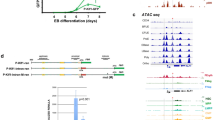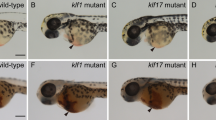Abstract
ERYTHROID Krüppel-like factor (EKLF) was originally isolated from erythroid cell RNA by differential screening and shown to be erythroid-specific, although a low level of EKLF was found in mast cell lines1,2. EKLF contains three zinc-fingers homologous to those found in the Kriippel family of transcription factors. Because it binds the sequence CCACACCCT, EKLF may affect erythroid development as a result of its ability to bind to the CAC box in the promoter of the β-globin gene1,2. Mutation of this element leads to reduced pβ-globin expression3-5and it appears to mediate the effect of the globin locus control region on the promoter6. Here we inactivate the EKLF gene through insertion of a lacZ reporter gene by homologous recombination in embryonic stem (ES) cells. Heterozygous EKLF+/- mice show that the reporter gene is expressed in a developmental!) specific manner in all types of erythroblasts in the fetal liver and adult bone marrow. Homo-zygous EKLF-/- mice appear normal during the embryonic stage of haematopoiesis in the yolk sac, but develop a fatal anaemia during early fetal life when haematopoiesis has switched to the fetal liver. Enucleated erythrocytes are formed but these do not contain the proper amount of haemoglobin. We conclude that the transcription factor EKLF is essential for the final steps of definitive erythropoiesis in fetal liver.
This is a preview of subscription content, access via your institution
Access options
Subscribe to this journal
Receive 51 print issues and online access
$199.00 per year
only $3.90 per issue
Buy this article
- Purchase on Springer Link
- Instant access to full article PDF
Prices may be subject to local taxes which are calculated during checkout
Similar content being viewed by others
References
Miller, I. S. & Bieker, J. J. Molec. cell. Biol. 13, 2776–2786 (1993).
Feng, W. C., Southwood, C. M. & Bieker, J. J. J. biol. Chem. 269, 1492–1500 (1994).
Orkin, S. H. et al. Nature 296, 627–631 (1982).
Orkin, S. H., Antonarakis, S. E. & Kazazian, H. H. J. biol. Chem. 259, 8679–8681 (1984).
Kulozik, A. E., Bellan-Koch, A., Bail, S., Kohne, E. & Kleihauer, E. Blood 77, 2054–2058 (1991).
Antoniou, M. & Grosveld, F. Genes Dev. 4, 1007–1013 (1990).
Kalderon, D., Roberts, B., Richardson, W. D. & Smith, A. E. Cell 39, 499–509 (1984).
Thomas, K. R. & Capecchi, M. R. Cell 51, 503–512 (1987).
Hooper, M., Hardy, K., Handyside, A., Hunter, S. & Moule, M. Nature 326, 292–295 (1987).
Mansour, S. L., Thomas, K. R. & Capecchi, M. R. Nature 336, 348–352 (1988).
Robertson, E. J. Teratocarcinomas and Embryonic Stem Cells (IRL, Oxford and Washington DC, 1987).
Ploemacher, R. E., Van Soest, P. L., Boudewijn, A. & Neben, S. Leukaemia 7, 1374–1380 (1993).
Wong, P. M. et al. Blood 62, 1280–1288 (1983).
Chada, K. et al. Nature 314, 377–380 (1985).
Epperly, B. R., Bergenhem, N. C. H., Venta, P. J. & Tashian, R. E. Gene 131, 249–253 (1994).
Beaumont, C., Porcher, C., Picat, C., Nordmann, Y. & Grandchamp, B. J. biol. Chem. 264, 14829–14834 (1989).
Eleouet, J. F. & Romeo, P. H. Eur. J. Biochem. 272, 763–770 (1993).
Donze, D., Townes, T. & Bieker, J. J. biol. Chem. 270, 1955–1959 (1995).
Behringer, R. R., Ryan, T. M. & Palmiter, R. D. Genes Dev. 4, 380–389 (1990).
Enver, T., Raich, N. & Ebens, A. S. Nature 344, 309–313 (1990).
Hanscombe, O. et al. Genes Dev. 5, 1387–1394 (1991).
Bonnerot, C. & Nicholas, J. F. Meth. Emzym. 225, 451–469 (1993).
Strouboulis, J., Dillon, N. & Grosveld, F. Genes Dev. 6, 1857–1864 (1992).
Author information
Authors and Affiliations
Rights and permissions
About this article
Cite this article
Nuez, B., Michalovich, D., Bygrave, A. et al. Defective haematopoiesis in fetal liver resulting from inactivation of the EKLF gene. Nature 375, 316–318 (1995). https://doi.org/10.1038/375316a0
Received:
Accepted:
Issue Date:
DOI: https://doi.org/10.1038/375316a0
This article is cited by
-
Schistosoma japonicum EKLF/KLF1 is a potential immune target to tackle schistosomiasis
Parasites & Vectors (2023)
-
An extra-erythrocyte role of haemoglobin body in chondrocyte hypoxia adaption
Nature (2023)
-
Cooperative contributions of the klf1 and klf17 genes in zebrafish primitive erythropoiesis
Scientific Reports (2023)
-
Identification of a genomic DNA sequence that quantitatively modulates KLF1 transcription factor expression in differentiating human hematopoietic cells
Scientific Reports (2023)
-
Epigenomic analysis of KLF1 haploinsufficiency in primary human erythroblasts
Scientific Reports (2022)
Comments
By submitting a comment you agree to abide by our Terms and Community Guidelines. If you find something abusive or that does not comply with our terms or guidelines please flag it as inappropriate.



